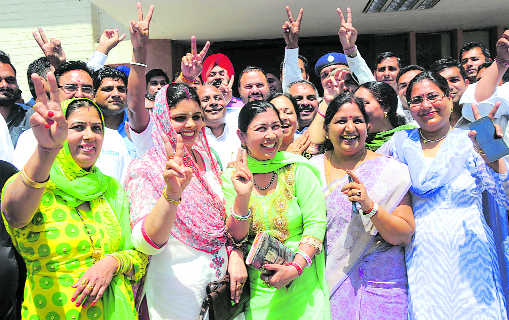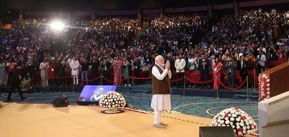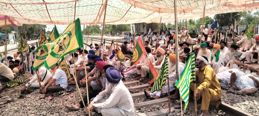
Woman power to the fore? Newly elected members celebrate after the zila parishad elections in Karnal. Tribune photo
S.S Sangwan
The fifth general municipal election (GME) in Haryana was held on May 22, 2016, after imposing the minimum education qualification as well as and four other conditions such as no arrears of loans from cooperatives, electricity bills and a functional toilet at the place of residence.
The elections to Pachayati Raj Institutions (PRIs) was held with these conditions in January 2016, which has already been discussed for inclusiveness in an earlier article. But after PRI elections, Haryana witnessed the violent Jat quota stir in February 2016. The impact of this stir along with that of the educational qualification is being discussed on the basis of results of the municipal elections in 2016 and 2010. The parameters like share of women, Scheduled Castes, backward class, youth along with distribution of elected candidates by education qualification was culled out from the data of the State Election Commission, Haryana. (See table).
Share of women
Column three of the table shows that the share of elected women members of municipal committees and councils has increased to about 46 per cent in GME 2016 from 40 per cent in 2010, as against their 33 per cent reserved seats. This quantum jump of about 24 per cent in women’s share may be partly attributed to educational qualifications and largely to the conditions of clearing arrears of outstanding loans and bills. In the state, loans and bills are rarely in the names of women. Even the contesting women were more at 44 per cent of total candidates in 2016, against 38 per cent in 2010. It clearly depicts that the imposed conditions have been favourable to women. It is a welcome and positive outcome in a state that is more known for the suppression of women. With their increase in numbers, their active participation may also improve. Moreover, the representatives without any dues may not support the defaulters of banks and electricity, though they may motivate others to pay.
Share of SCs and OBCs
The representation of Scheduled Caste members in municipal councils and committees is about 22.21 per cent in GME, 2016, as compared to 19.43 per cent in 2010 against their urban population of about 18 per cent in the state according to the 2011 Census. The SC representatives in 2016 have increased by about 3 per cent points, that is about 15 per cent. Similarly, in PRI elections of January this year, an increase of about 11 per cent in Scheduled Caste members was revealed over 2010. Hence, the imposition of education and other qualifications has favoured the inclusiveness of Scheduled Castes. Their increased representation in the municipal elections than the panchayat elections may indicate polarisation after the stir in February.
This polarisation is more perceptible from the share of other backward classes (OBCs) at 23.18 per cent in 2016 GMEs as compared to 17.50 per cent in the 2010 election. This quantum jump of 32.46 per cent in OBC representatives may be largely attributed to the convergence of non-Jats after the Jat stir in February 2016. To illustrate this, the OBC, SC and general representatives are about 47 per cent, 15 per cent and 37 per cent, respectively in the Jhajhar municipal committee in 2016 and Jat representaion is only one against 6 to 7 in earlier elections.
Participation of youth
The average age of the elected members in municipal elections, 2016, was 38 years for males and 36 years for females. In 2010, only 39 per cent males and females were below 40 years. Thus, education qualification has a significant positive impact on the participation of younger voters. Moreover, the voting percentage is higher at 78 per cent as compared to about 75 per cent in 2010. In panchayat elections, the voting percentage was up to 87 per cent in 2016, as compared to 85 per cent in 2010 and 82 per cent in 2005. It indicates the positive effect of participation of voters, especially youth, in the grassroot-level democratic process.
Increase in educated representatives
In the elected representatives of municipalities in 2016, there is no illiterate but in 2010, their share was 8.37 per cent. The primary and middle pass decreased to 13 per cent in 2016 from above 25 per cent in 2010. The share of 10th and 12th pass members increased to 55 per cent from 39 per cent. However, the share of graduates and above shows a decline from 27 per cent to 22 per cent. This may partly be due to the indifference of well-qualified persons from politics. Almost similar changes are discernible from the education level of representatives of PRIs, elected in January, after imposition of the education qualification. The Supreme Court, while upholding the education qualification on December 10, 2015, has expected the educated representatives may be more vibrant in discharging their allotted functions. It seems that the working conditions of both rural and urban local bodies may still be restricting the entry of more qualified persons. The results of panchayats and municipal elections in 2016 indicate that the impact of educational qualification is largely restricted to fulfilling the minimum qualification. Let us hope that more representation of educated especially women, SCs and OBCs makes the functioning more democratic. It may attract more educated persons and in turn may induce more qualified persons to participate in elections in future.
Issues of concern
The participation in terms of nominations in GMEs has decreased from 3,985 in 2010 to 3,624 candidates in 2016 — in spite of an increase in seats from 777 to 824. The number of contesting candidate per seat was 5.13 in 2010 and was reduced to 4.40 in 2016. However, contesting women and OBCs candidates have increased in 2016. The unanimous elected candidates were about 3 per cent in 2010 but there was none in 2016. It is to ne noted the in the PRI polls in January 2016 unanimously elected representatives were 56 per cent as compared to 34 per cent in 2010. It seems that the confrontation among Jats and non-Jats during the quota stir in February, 2016 has enormously dented the social harmony in the state.
A higher participation of youth and women is a positive development but channelling of their energy poses a serious challenge to the state government. It will require the cooperation of block officials, appropriate training, equipping gram panchayats with computers and more funds.
The writer is Professor, SBI Chair at CRRID, Chandigarh.



























